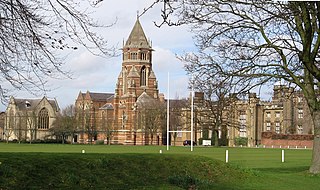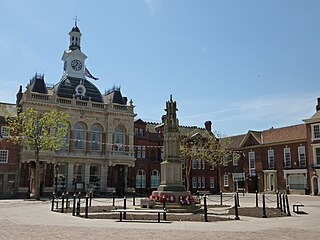
Rugby School is a public school in Rugby, Warwickshire, England.

Rugby fives is a handball game, similar to squash, played in an enclosed court. It has similarities with Winchester fives and Eton fives. It is played mainly in the United Kingdom.
King Edward's School or King Edward VI School may refer to:

Retford, also known as East Retford, is a market town in the Bassetlaw District in Nottinghamshire, England, and one of the oldest English market towns having been granted its first charter in 1105. It lies on the River Idle and the Chesterfield Canal passes through its centre. Retford is 26 miles (42 km) east of Sheffield, 23 miles (37 km) west of Lincoln and 31 miles (50 km) north-east of Nottingham. The population at the 2011 census was 22,013.

King Edward's School (KES) is an independent day school for boys in the British public school tradition, located in Edgbaston, Birmingham. Founded by King Edward VI in 1552, it is part of the Foundation of the Schools of King Edward VI in Birmingham. It is a member of the Headmasters' and Headmistresses' Conference. As of 2021, King Edward's School was ranked as one of the top 10 International Baccalaureate schools in the United Kingdom and amongst the top 25 in the world. In 2020, the Tatler School Guide described the school as “academically elite,” going on to note that it is “in the process of upping its already sky-high intellectual ante [...] with top-of-the-range sporting facilities and a raft of extracurricular activities [...] it comes as no surprise that leavers head off to a shining constellation of universities.”

King Edward VI Five Ways (KEFW) is a highly selective co-educational state grammar school for ages 11–18 in Bartley Green, Birmingham, England. One of the seven establishments of the Foundation of the Schools of King Edward VI, it is a voluntary aided school, with admission by highly selective examination. It was founded in Five Ways, Birmingham in 1883 and retained its name when it moved to Bartley Green in 1958.
King Edward VI Handsworth School is a grammar school for girls aged 11–18 located in Handsworth, Birmingham, England. It is part of the Foundation of the Schools of King Edward VI. The school was founded in 1883 as King Edward's Aston on the site where its brother school, King Edward VI Aston School, remains to this day. In 2019 there were 1086 girls on roll. Pupils must pass an 11-plus entrance exam to get into the school. The King Edward Schools are fiercely competitive to get admission to, as only 1 in 10 are successful in passing the entrance exam. The King Edward VI Foundation holds its exams at the same time, and generally a candidate will sit one exam for multiple schools within the foundation. Notable leaver's destinations from this school in previous years have been Birmingham, Aston, Oxford, and Nottingham. The leavers destinations by course were mainly medicine, dentistry, law, business studies and computer science.

Rutlish School is a state comprehensive school for boys, formerly a grammar school with the same name originally located on Rutlish Road, Merton Park, and relocated in 1957 on nearby Watery Lane, Merton Park, in southwest London.

King Edward's School (KES), Bath, Somerset, England is an independent co-educational day school providing education for 1,016 pupils aged 3 to 18. The school is a member of The Headmasters' and Headmistresses' Conference.
King Edward VI Grammar School is a grammar school located in Louth, Lincolnshire, England.

The Grammar School of King Edward VI at Stratford-upon-Avon is a grammar school and academy in Stratford-upon-Avon, Warwickshire, England, traditionally for boys only. However, since September 2013 the school has admitted girls into the Sixth Form. It is almost certain that William Shakespeare attended this school, leading to the school widely being described as "Shakespeare's School".
Lincolnshire is one of the few counties within the UK that still uses the eleven-plus to decide who may attend grammar school, in common with Buckinghamshire and Kent.
Ordsall Hall Comprehensive School was a comprehensive school situated on Ordsall Road in the market town of East Retford in the district of Bassetlaw, Nottinghamshire.

Derby School was a school in Derby in the English Midlands from 1160 to 1989. It had an almost continuous history of education of over eight centuries. For most of that time it was a grammar school for boys. The school became co-educational and comprehensive in 1972 and was closed/renamed in 1989. In 1994 a new independent school called Derby Grammar School for boys was founded.

King Edward VI Camp Hill School for Girls is a selective grammar school in Kings Heath, Birmingham, for students aged 11 to 18. It is one of the most academically successful schools in the United Kingdom, currently ranked 10th among state schools. It is one of seven schools in Birmingham that are part of the King Edward VI Foundation. It shares a campus with King Edward VI Camp Hill School for Boys and, in 1958, both schools moved from their original location in central Birmingham to Vicarage Road in the Birmingham suburb of Kings Heath. The buildings are connected and some facilities and activities are shared, but they are separate establishments. The name has been retained from the school's former site at Camp Hill.

King Edward VI College is a sixth form college located in Nuneaton, England, in Warwickshire. Currently, it teaches subjects in preparation for A-level examinations, for students generally aged sixteen to eighteen. The college presently accommodates approximately 1400 students from Warwickshire, West Midlands and neighbouring counties.

Clarborough is a village in the civil parish of Clarborough and Welham, in the district of Bassetlaw, Nottinghamshire, England. Clarborough is located 2 miles (3 km) north-east from the centre of Retford. In 2019 it had an estimated population of 1305.
The Minster School is a Church of England secondary school with sixth form in Southwell, Nottinghamshire, England, for children aged 11 to 18. There are approximately 1600 students on roll. It has a small selective junior section for boy and girl choristers from Southwell Minster and other pupils chosen for their musical ability. It has a smaller than average proportion of pupils on free school meals, or of ethnic minority origin or with Statement of Special Educational Needs.

King Edward VI Academy, is a coeducational bi-lateral secondary school and sixth form with academy status, located in Spilsby, Lincolnshire, England, for children between the ages of eleven and eighteen.
Retford Oaks Academy is a coeducational secondary school and sixth form located in the market town of Retford, Nottinghamshire, England, situated in the district of Bassetlaw.




































